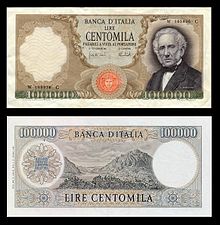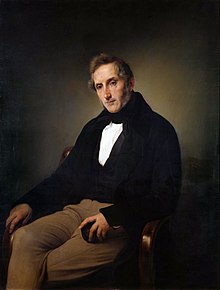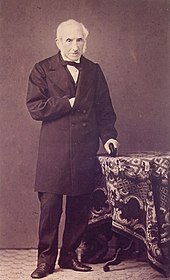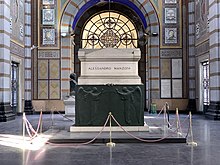Alessandro Manzoni
Alessandro Francesco Tommaso Antonio Manzoni (born March 7, 1785 in Milan , † May 22, 1873 ibid) was an Italian poet and writer . His most famous work is the novel I Promessi Sposi (German The bride and groom, also the betrothed ) published in 1827 .
Life
Manzoni's maternal grandfather, Cesare Beccaria , Marchese di Gualdrasco e di Villareggio (1738–1794), was a respected lawyer and writer as well as the author of the book Dei delitti e delle pene (Eng. On crime and punishment ), which has been translated into many languages . His mother Giulia (1762–1841) was also very interested in literature. Count Don Pietro (1736-1807), who was almost fifty years old at the time of Alessandro's birth, was officially issued as his father. He represented an old family who lived near Lecco , but who originally exercised strict feudal rule over Barzio in Valsassina (where the memory of their brutality is passed down in a saying that compares them to the torrents in the mountains). Manzoni's real father was probably Giovanni Verri, the youngest brother of the two respected Milanese lawyers and enlighteners Alessandro and Pietro Verri, with whom Giulia had been dating before they married.
As a result of the broken family relationships of his parents - Giulia separated from Don Pietro in 1792 and from then on lived with the rich and educated Count Carlo Imbonati, first in England, then in France - the young Alessandro was educated in church boarding schools from 1790 to 1803 , where he was only slowly learned and was initially considered a failure. At the age of fifteen, however, he developed a passion for poetry, made first contacts with writers and exiled patriots and wrote a. a. a fiery, Jacobean- inspired poem entitled Del trionfo della Libertà (“On the Triumph of Freedom”). 1805 , after the death of his father, who is now twenty-year-old moved with his mother to Paris and rushed there in the intellectual life of the capital of the Napoleonic Empire, where he especially among the Voltaire made many friends, vehicle trailers, especially the highly educated Claude Fauriel , the introduced him to new literary trends and the work of William Shakespeare . Through Fauriel he came into contact with the ideas of German Romanticism even before they were spread in Europe by Madame de Stael . In the years 1806-1807 he appeared for the first time with two poems to the public. The first, an ode entitled Urania , was still in the classical style of which he would later become the sharpest opponent. The other was an elegy in free verse on the death of Count Carlo Imbonati, from whom he had inherited a considerable fortune through his mother, including the villa in Brusuglio north of Milan, which from then on became his main residence.
It was only after his marriage to the Geneva banker's daughter and Calvinist Henriette Blondel in 1808 that Manzoni, who until then had been rather anti-clerical due to his church schooling education, came through his wife , who converted in 1810, to that Jansenist- tinged Catholicism that would shape his whole subsequent life.
The marriage to Henriette Blondel turned out to be extremely happy and Manzoni led a secluded domestic life for many years. During this period he devoted his intellectual energy to the Inni sacri ("Holy Hymns"), a series of spiritual poems, and a treatise on Catholic morality. He understood this work, which he undertook under the religious guidance of his confessor, as a repentance for his earlier disbelief.
In 1818 he had to sell his paternal inheritance because he had lost money to a dishonest broker. On this occasion his characteristic generosity was shown in dealing with his farmers, who owed him to him. Not only did he free them from all debts, but he also allowed them to keep all of the upcoming corn harvest.
In 1819 Manzoni published his first tragedy, Il Conte di Carmagnola , which broke all classic conventions of the unity of place and time and sparked a lively controversy. In an influential literary magazine, it was sharply criticized by the representatives of Italian purismo ( linguistic purity ) around the writer and literary theorist Antonio Cesari , whereupon no less a person than Goethe defended it.
The death of Napoleon on May 5, 1821 inspired Manzoni to write his ode Il Cinque maggio (“The fifth of May”), which is one of the most famous poems in the Italian language and was first written by Goethe, then many more times a. a. by Paul Heyse , was translated into German. Manzoni was deeply depressed by the political events of that year and the imprisonment of many of his friends, and his further work was mainly determined by historical studies with which he tried to distract himself after his retreat to Brusuglio. In 1822 he published the tragedy Adelchi ("Adelgis"), which is about the end of the Lombard domination in Northern Italy by Charlemagne and contains many allusions to the Austrian rule in Milan and Venice.
At the same time, after extensive studies of the history of Milan in the 17th century and especially the great plague that raged there in 1630 , Manzoni designed and developed the novel I Promessi Sposi , the first version of which he completed in September 1823 under the title Fermo e Lucia , but immediately subjected to a thorough revision and partly completely rewritten. The second version appeared in three volumes in 1827 and immediately elevated its author to the first rank of literary celebrity. Thanks to the emphatic advocacy of Goethe , to whom Manzoni had sent the finished novel to Weimar, two German translations were commissioned in parallel in Berlin and Leipzig (which have been followed by a good dozen more to this day). In the 1830s, Manzoni revised the novel in detail once more in order to clear it of Lombard dialect and to present it in Tuscan written language so that it could be read by all Italians throughout the country. He published this final version in sequentials 1840-42 together with a kind of encore, titled Storia della Colonna infame ("History of the Column of Shame"), which deals with a special episode during the great plague and is also of legal historical interest.
After that Manzoni did not write any more literary works, but only treatises on Italian history and above all on the need for a generally understandable Italian language. Nevertheless, he enjoyed a great reputation well into old age as a kind of Italian national poet, especially after the unification of Italy , for which he had worked tirelessly. In 1860 he was appointed senator of the new kingdom . In 1844 he was accepted as a foreign member of the German order Pour le Mérite for science and the arts and since 1834 he was a member of the Accademia Roveretana degli Agiati .
The further years of life were overshadowed by many personal losses. The death of his wife in 1833 was followed by six of his nine children and his mother. In 1837 he married again, this time Teresa Borri, widow of Count Stampa, whom he also survived, while only two of the nine children from his two marriages died after him. The death of his eldest son on April 28, 1873 was the last blow that hastened its end. After a fall while leaving a church, through which he sustained a skull injury, he suffered a collapse, fell ill quickly and died on May 22, 1873 of meningitis . All of Italy mourned for him, his burial was celebrated with almost royal pomp and his remains were accompanied by a huge funeral procession to the Cimitero Monumentale in Milan , where princes and all high civil servants paid their final respects. His most distinguished monument, however, is Verdi's Requiem , which the composer dedicated to him and which premiered in 1874 on the first anniversary of Manzoni's death.
Manzoni's first biographies were written by Cesare Cantù (1885), Angelo De Gubernatis (1879) and Arturo Graf (1898). Some of his letters were published by Giovanni Sforza (1882).
Works translated into German
- Inni sacri , 1815 (German holy hymns , translated by Paul Heyse , Berlin 1889)
- Osservazioni sulla morale cattolica , 1819 (German remarks on Catholic morality , translated by Joseph v. Orsbach, Cologne 1835; also considerations on Catholic morality , translated by Franz Arens, Munich 1923 = vol. 6 of the [unfinished] work edition of Hermann Bahr and Ernst Kamnitzer, Munich 1923 ( DNB ))
- Il cinque Maggio , 1821 (German: The 5th of May , translated by Johann Wolfgang von Goethe , 1822), Paul Heyse (1871) and many others
- Adelchi , 1822 (German Adelgis , translated by Karl Streckfuss, Berlin 1827 and translated by Johann Friedrich Heinrich Schlosser , Heidelberg 1856 (reprint) )
- La Monaca di Monza (section from Fermo e Lucia , 1823), published posthumously. 1954 (German: The nun of Monza , translated by Heinz Riedt, Nymphenburger Verlagsanstalt, Munich 1964, German 1988)
- I Promessi Sposi , 1827, rev. Edition 1840–42 (numerous German translations under the title Die Verlobten , by Daniel Leßmann , Berlin 1827, rev. 1832, and Eduard v. Bülow, Leipzig 1828, rev. 1837, to Johanna Schuchter, Munich 1923, and Ernst Wiegand Junker, Munich 1960, online (Berlin 1860, Leßmann); so far last new translation under the title Die Brautbaren , German by Burkhart Kroeber , Hanser , Munich 2000; dtv 2003)
- Storia della Colonna Infame , 1842 (German: Die Schandsäule , after an anonymous translation from 1843, edited and translated by Wolfgang Boerner, foreword by Leonardo Sciascia , Verlagsgruppe Vis-à-vis, Berlin 1988, German 1990; new translation: History of the Schandsäule , in German by Burkhart Kroeber, with a foreword by Umberto Eco and an afterword by Michael Stolleis , Dieterich'sche Verlagsbuchhandlung Mainz 2012)
- Del romanzo storico , 1850 (German about the historical novel , translated by Franz Arens, in Vol. 5 of the above-mentioned edition, Writings on Philosophy and Aesthetics , Munich 1923 ( DNB ))
Secondary literature
- Hugo Blank, Goethe and Manzoni: Weimar and Milan , Winter, Heidelberg 1988
- Werner Ross (eds.), Goethe and Manzoni: German-Italian cultural relations around 1800 , Niemeyer, Tübingen 1989
- Hugo Blank (ed.), Weimar and Milan: Letters and documents on an exchange between Goethe and Manzoni , Winter, Heidelberg 1992
- Natalia Ginzburg, La famiglia Manzoni , Turin 1983 (German: The Manzoni family , translated by Maja Pflug and Andrea Spingler, Claassen, Düsseldorf 1988; new edition by Wagenbach, Berlin 2001)
- Piero Floriani: MANZONI, Alessandro. In: Mario Caravale (ed.): Dizionario Biografico degli Italiani (DBI). Volume 69: Mangiabotti – Marconi. Istituto della Enciclopedia Italiana, Rome 2007.
- Burkhart Kroeber , Manzoni's Napoleon Ode and its German translations , accents . Zeitschrift für Literatur, Issue 3 / June 2010, pp. 268–287; extended in: Marie Luise Knott , Georg Witte (ed.), In other words. On the poetics of translation , Matthes & Seitz, Berlin 2014, pp. 43–69.
- Realino Marra (ed.): Diritto e castigo. Immagini della giustizia penale: Goethe, Manzoni, Fontane, Gadda . il Mulino, Bologna, 2013. ISBN 978-88-15-24619-6
- Michael Bernsen, Stories and History: Alessandro Manzoni's 'I promessi sposi' , literature. Research and Science 32, Berlin: LIT Verlag 2015. Review in Romance Studies
- Carl Marquard Sauer (1827-1896): Alessandro Manzoni. A study . Prague 1871, online
- Annina Volonterio : Donne nella vita di Alessandro Manzoni. Torino 1960
Commemoration

Alessandro Manzoni was depicted on the Italian Lire 100,000 banknote issued by the Banca d'Italia between 1967 and 1979.
Web links
- Literature by and about Alessandro Manzoni in the catalog of the German National Library
- Works by and about Alessandro Manzoni in the German Digital Library
- Works by Alessandro Manzoni in the Gutenberg-DE project
- Works by Alessandro Manzoni at Zeno.org .
- Works in Italian
- Works by Alessandro Manzoni : text, concordances, word lists and statistics
notes
- ^ Online , in German, page 392ff .; as a print in German by Paul Heyse : Gesammelte Werke. Series 5: Italian Poets in Translations. Ed. Markus Bernauer, Norbert Miller . Vol. 1: Giuseppe Parini , Vittorio Alfieri , Vincenzo Monti , Ugo Foscolo , Manzoni. Georg Olms, Hildesheim 1999 ISBN 3487109875 (first Hertz, Berlin 1889) available in google books. Manzoni sings here the goddess and bring them with Pindar related
| personal data | |
|---|---|
| SURNAME | Manzoni, Alessandro |
| ALTERNATIVE NAMES | Manzoni, Alessandro Francesco Tommaso (full name) |
| BRIEF DESCRIPTION | Italian writer |
| DATE OF BIRTH | March 7, 1785 |
| PLACE OF BIRTH | Milan |
| DATE OF DEATH | May 22, 1873 |
| Place of death | Milan |


